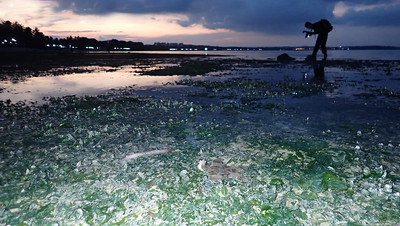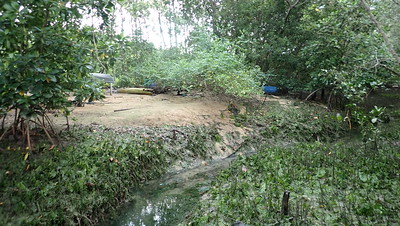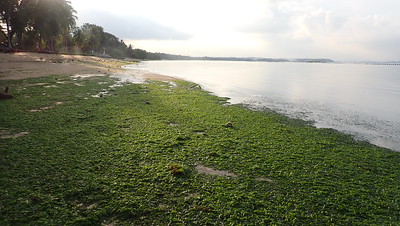The rare tree is still standing and we encountered lots of sea stars. As well as many other fascinating creatures.
Our northern shores are usually rich in echinoderms. Today, many kinds of sea stars dotted the shores! I was happy to see many Biscuit sea stars both large and small as we had not seen them recently on our surveys of the northern shores. There were many Cake sea stars, some bright orange, others more camouflaged. I also saw one Eight-armed sea star and the Sand stars came out after sunset: Plain sand stars and Painted sand stars.
There were also many kinds of sea cucumbers! A first sighting for this location was a Big synaptid sea cucumber. There were not as many Pink warty sea cucumbers as at Changi, and here they were tiny. I didn't see any Thorny sea cucumbers. There were several Garlic bread sea cucumbers, many Ball sea cucumbers. I saw one Orange sea cucumber and one See-through sea cucumber.
The shore here is soft and silty, in some parts so soft you can easily sink up to your knees! This is perfect for burrowing cnidarians like cerianthids and sea pens. Flowery sea pens were particularly abundant in some parts, many individuals found in a small area. There were also many large Swimming anemones, which don't burrow and can actually swim. Prowling among the seaweeds in a pool of water is this tiny ferocious predator: A Pygmy squid. This squid doesn't get much bigger and I have seen it catch prey as big or bigger than itself! Our first entry for this location on the wild fact sheets!
Among the interesting finds was this male Mangrove horseshoe crab. You can tell it's a male, because the claws on his first legs are modified for clinging onto the female. And it's a Mangrove horseshoe crab because this special claws have two 'fingers', while the Coastal horseshoe crab has one 'finger'. More on how to tell apart these two kinds of horseshoe crabs.
The rest of the team ventured to the beacon on the shore and found it encrusted with sponges and other marine life.
They also saw a nudibranch!
There is a small patch mangroves near the mouth of Sungei Loyang. This is home to the beautiful Bakau mata buaya, listed as 'Critically Endangered' not just in Singapore but globally too! It is now the last large Bakau mata buaya on the mainland (the one at Sungei Buloh is dead). The situation is similar to our last visit earlier this year in Jan 2020. The tree is still standing, even though another tree has fallen over next to it (a Nyireh bunga). The embankment behind the tree has also eroded away, but the base of the tree looks strong and healthy. I couldn't see any flowers on the tree (but it is very tall and getting dark). There were only a few calyx on the ground and a few growing propagules that might have come from the tree. There wasn't much litter accumulated near the tree.
This tiny patch of mangroves seems to be doing well. The mud is nice and soft and smelly. There are lots of little saplings everywhere. The big trees are doing well. There seems to be less trash than usual. Although the kayaks 'stored' there are still there. They appear abandoned.
Large areas of the shore are covered in a bloom of fresh green Sea lettuce seaweed. This is normal and happens seasonally, usually towards the end of the year.
There are still good growths of seagrasses on the shores here. Just Spoon seagrass with both small and large leaves, growing particularly thickly on the soft silty edges away from the shore. Unlike in Jan 2020, today I didn't see large patches of bleaching seagrasses.
Those large vessels that we always see docked in this area, I found out belongs to Oil Spill Response, a global NGO that is activated to clean up oil spills. This is one of their regional bases, where they are on standby with equipment and supplies to deal with oil spills. Here's how they tackle oil spills, from a talk I attended in Mar 2014 ago by Oil Spill Response. Today, we saw several stray dogs resting on the sand bar (photo below). The dogs barked but left us alone as we didn't disturb them. We also saw a person throw plastic bags of food for the dogs onto the shore and areas nearby. He said he goes back later to collect the bags.
This shore is very well used. There were many people digging large holes on the shore with a cangkul, probably looking for bait worms for fishing.
There were also several people slowly combing the shore while holding plastic bags and containers of their finds. Some continued even after sunset.
Despite the heavy harvesting, I still saw many of the 'collectible' marine life. Although I didn't see any adult Gong gong snails, there were many juveniles with thinner shells. There were also many Window pane clams, some Large cockles, and many small swimming crabs of various kinds.
Photos by others on this trip
Loh Kok Sheng
Others on this trip: Jonathan Tan
Other shore surveys
Marcus Ng surveyed Changi
Vincent Choo surveyed Sembawang Beach














